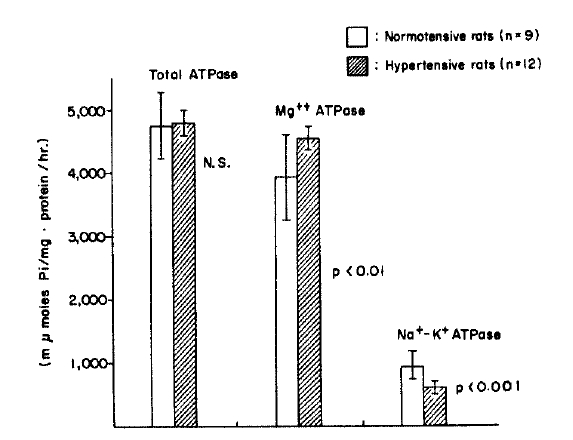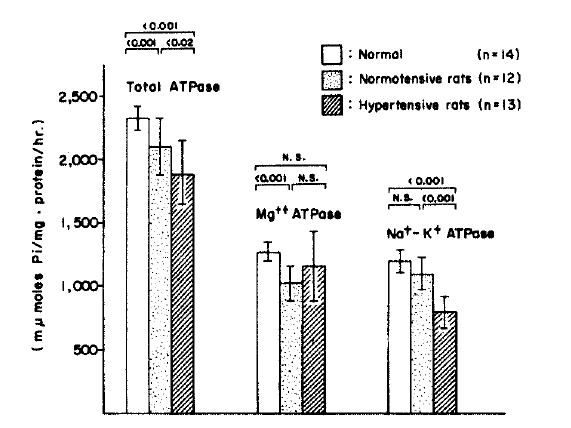1. Licht A, Danovitch GM. Sodium metabolism and volume regulation. Current Nephrol VI:283. 1983.
2. De Wardener HE, Mills IH, Clapham WF, Hayter CJ. Studies on the efferent mechanism of the sodium diuresis which follows the administration of intravenous saline in the dog. Clin Sci 21:249. 1961.

3. Buckalew VM, Gruber KA. Natriuretic hormone : The kidney in liver disease. Edited by Ebstein M 479ŌĆō4991984.

6. Raghavan SR, Gonick HC. Partial purification and characterization of natriuretic factor from rat kidney. Proc Soc Exp Biol Med 164:101. 1980.


7. Louis F, Favre H. Natriuretic factor in rats acutely eypanded by RingerŌĆÖs versus albumin solution. Kidney Int 18:20. 1980.


8. Bourgoignie J J, Rennell JP, Jacop A. Sodium metabolism and volume regulation. Current Nephrol 111:1ŌĆō401979.
9. Ylitalo P, Hepp R, Oster P, Monring J, Gross F. Effect of varying sodium intake on blood pressure and renin-angiotension system in subtotally nephrectomizedrats. J Lab Clin Med 88:807. 1976.

10. Ylitalo P, Gross F. Hemodynamic changes during the development of sodium-induced hypertension in subtotally nephrectomized rats. Acta Physiol Scand 106:447. 1979.


12. Bianchi G, Barlassina C. Renal function in essential hypertension. Hypertension. In: Genest J, ed, et al. I:54ŌĆō73McGraw-Hill Book Co, 1983.
13. Blaustein M P. Sodium ions, calcium ions, blood pressure regulation, and hypertension : A reassessment and a hypothesis. Am J Physiol 232(3):c165ŌĆōc1731977.


14. Blaustein MP, Hamlyn JM. Role of a natriuretic factor in essential hypertension : A hypothesis. Ann Intern Med 93:785. 1983.

15. Blaustein MP, Hamlyn JM. Sodium transport inhibition, cell calcium, and hypertension : The natriuretic hormone/Na
+-Ca
++ exchange/hypertension hypothesis. Am J Med 5:45. 1984.

16. Bond GH, Green JW. Effects of monovalent cations on the (Mg
++-Ca
++) dependent ATPase of the red cell membrane. Biochm Biophys Acta 241:393. 1971.

17. Lowry OH, Rosenbrough NJ, Farr AL, Randall RS. Protein measurement with the Folin-phenol reagent. J Biol Chem 193:265.


18. Fiske CH, SubbaRow Y. Cited from J Clin Invest. In: Silva P, Hayslett JP, Ebstein FH, eds. 52:2665ŌĆō26711973.
19. Huot SJ, Pammani MB, Clough DT, Haddy FJ. The role of sodium intake, the Na-K pump and a ouabain-like humoral agent in the genesis of reduced renal mass hypertension. Am J Nephrol 3:92. 1983.


20. Schwartz A, Lindenmyer GE, Allen JC. The sodium potassium adenosine triphosphatase: Phamacological, physiological and biochemical aspects. Pharm Rev 27:3. 1975.

21. Sweadner KJ, Goldin SM. Active transport of sodium and potassium ions : Mechanism, function and regulation. N Engl J Med 302:777. 1980.


22. Anner BM. The receptor function of Na
+-K
+ activated adenosine triphosphatase system. Biochem J 227:1. 1985.



24. Rossier BC, Geering K, Kraehenbuhl JP. Mechanism of action of aldosterone : Role of Na-K ATPase. Nephrology. Pro. IXth Intern Cong Nephrol I:388ŌĆō3961984.

25. Cort JH, Dousa T, Pliska V, Lichardus B, Safarova J, Vranesik M, Rudinger J. Saliuretic activity of blood during carotid occlusion in the cat. Am J Physiol 215:921. 1968.


26. Gruber KA, Whitaker JM, Buckalew VM. Engoenous digitalis-like substance in plasma of volume-expanded dog. Nature 287:743. 1980.


27. Licht A, Stein S, McGregor CW, Bourgsignie JJ, Bricker NS. Progress in isolation and purification of an inhibitor of sodium transport obtained from dog urine. Kidney Int 21:339. 1982.


28. De Bold AJ, Sonnenberg H, Ackermann U, Blaine EH, Briggs JP, Cole BR, Keeler R, Solomon S, Spinelli F, Trippodo NC, Maack T. Atrial natriuretic factor. Nephology. Proc IXth Intern Cong Nephrol I:257ŌĆō2591984.

29. Cantin M, Genest J. The heart and the atrial natriuetic factor. Endocr, Rev 6:107. 1985.

30. Clarkson EM, Raw SM, De Wardener HE. Further observations on a low-molecular weight natriuretic substance in the urine of normal man. Kidney Int 16:710. 1979.


31. Spustova V, Gerykova M, Lichardus B, Dzurik R. Analytical identity of an inhibitor of sodium transport isolated from human serum and urine. Nephron 39:18. 1985.


32. Yoon Young Suk, Yang Chul Woo, Cho Hyun Mi, Lee Kil Whan, Son Hyun Sik, Chun Young Soo, Choi Kyo Bo, Bang Byung Kee, Cho Ku Chul. Effect of hemodialysis on erythrocyte Na+-K+ ATPase activity of uremic subjects. Kor J Int Med 35:38. 1986.
33. Haddy FJ. Sodium-potassium pump in low-renin hypertension. Ann Intern Med 93:781. 1983.

34. De Wardener HE, Mills IH, Clapham WF, Hayter CJ. Studies on the efferent mechanism of the sodium diuresis which follows the administration of intravenous saline in the dog. Clin Sci 21:249. 1961.

35. De Wardener HE, Clarkson EM. Natriuretic hormone. The kidney : Physiology and pathophysiology In: Seldin , Giebisch , eds. 2:1013ŌĆō10311985.

36. De Wardener HE, MacGregor GA. The natriuretic hormone and its possible relationship to hypertension. Hypertension In: Genest J, ed, et al. I:84ŌĆō951983.
37. Kim Yong Soo, Chang Yoon Sik, Yoon Young Suk, Kim Young Woo, Lee Kwang Wo, Son Ho Young, Kang Sung Ku, Bang Byung Kee. Inhibition of renal Na+-K+ ATPase activity due to acute saline loading in rats. Kor J Int Med 27:1241. 1984;(abstract).
38. Welt LG. A further evaluation of erythrocyte sodium transport in control subjects and patients with uremia. Nephron 6:406. 1969.


39. Cole CH. Decreased ouabain-sensitive adenosine triphosphatase activity in the erythrocyte membrane of patients with chronic renal disease. Clin Sci Molec Med 45:775. 1973.

40. Edmondson R, Hilton P, Jones N, Patrick J, Thomas R. Leukocyte sodium transport in uremia. Clin Sci Mol Med 49:213. 1975.

41. Bello-Reuss E, Grady T, Mazumdar D. Serum vanadium levels in chronic renal disease. Ann Intern Med 91:743. 1979.


42. Cole CH, Malety R. Changes in erythrocyte membrane ouabain-sensitive adenosine triphosphatase after renal transplantation. Clin Sci Mol Med 48:239. 1975.


43. Kramer HH, Gospodinov D, Kruck F. Functional and metabolic studies on red blood cell sodium transport in chronic uremia. Nephron 16:344. 1976.


44. Cole CH, Steinberg R, Guttmann R. Altered erythrocyte sodium efflux following renal transplantation. Nephron 20:248. 1978.


45. Davidman M, Opsahl J. Mechanism of elevated blood pressure in human essential hypertension. Med Clin N Am 58:301. 1984.










 PDF Links
PDF Links PubReader
PubReader ePub Link
ePub Link Full text via DOI
Full text via DOI Download Citation
Download Citation Print
Print



